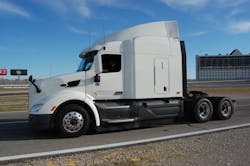TEXAS MOTOR SPEEDWAY. Figuring out the price tag for self-driving trucks is still imprecise at this point in their development, with the total cost of operation (TCO) benefits of autonomous technology “still not clear,” explained Stephan Keese, senior partner for the North American automotive practice at global consulting firm Roland Berger.
“It’s not clear how quickly the costs for autonomous truck technology will come down,” he said during the first day of the North American Automated Trucking Conference being held here at the Texas Motor Speedway. “About 80% of the total costs of autonomous truck systems will be in software, not hardware."
It’s also hard to assign particular technologies only to truck automation, he added, since many of them – including radar, cameras, and other systems – can also fulfill other roles on the vehicle, such as in collision mitigation, lane keeping, etc.
According to Roland Berger’s figuring, the specific costs needed to achieve each of the five “stages” or “levels” of autonomous vehicle operation – stages defined by the National Highway Traffic Safety Administration (NHTSA) – will range between $4,000 and $7,000 per stage, not including the $5,000 premium for an fully-automatic or automated mechanical transmission (AMT) needed to make a truck “self-driving.”
Keese noted that Stage 1 “driver assistance” technologies are already in the marketplace – such as the aforementioned collision mitigation and lane keeping systems – with Stage 2 “partial automation” technologies, such as automatic emergency braking (AEB) being road tested now and expected to be commercially launched in 2017.
The more difficult “coordinated automation” of Stage 3 system such as truck platooning is not expected to be market ready until 2020, with Stage 4's limited self-driving capability, dubbed “highway piloting,” on long stretches of open road not expected until 2025.
Though Roland Berger projects fully autonomous trucks could be ready for the road by 2030, Keese thinks it really won’t be until 2050 that self-driving trucks could be deployed.
“Having 99.9% certainty they [autonomous trucks] will work safely is not enough; we need absolute certainty they will operate in any environment 100% safely,” he said.
Several challenges exist to allow trucks to be either partially or fully self-driving, Keese explained, some technological and some human.First, backing up trucks is one of the most difficult operations and will prove complex for a machine to handle by itself. “It’s essentially a process all done within the driver’s brain; you may need 10 to 12 cameras to allow a machine to successfully replicate it,” he said.
Another huge question that Keese (seen at right) believes “there’s no answer for yet” is what will drivers do for 10 hours, sitting behind the wheel not driving, while being required enough to intervene “at a moment’s notice” should something go wrong.
“That is much more stressful that actual driving,” he said. “It takes a driver 90 seconds to become ‘full re-engaged’ after being unfocused; not just grabbing the steering wheel, which takes 2.5 seconds, but being able to process a situation.”
Keese added, too, that this technology won’t just require “acceptance” by truck drivers but also significant re-training as it takes getting used to “hands off” truck operation.
In terms of payback calculations for autonomous trucks, Roland Berger’s research indicates fleets want an 18 month return on investment (ROI) window.
The biggest opportunity for self-driving trucks to achieve that at the moment is via fuel savings, through more precise operation of the truck, with additional savings generated through “predictive maintenance” capabilities gleaned from all the data generated by the autonomous systems on board the vehicle.
“We’ve talked to several large fleets who’ve said they spend $1 million on fuel per day, and this is in a low-cost fuel environment,” Keese noted. “So even a 1% to 2% savings in fuel expense could mean huge savings.”
About the Author
Sean Kilcarr
Editor in Chief
Sean Kilcarr is a former longtime FleetOwner senior editor who wrote for the publication from 2000 to 2018. He served as editor-in-chief from 2017 to 2018.

